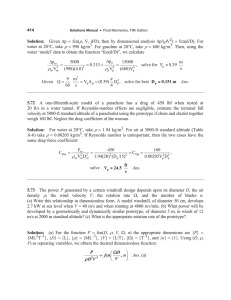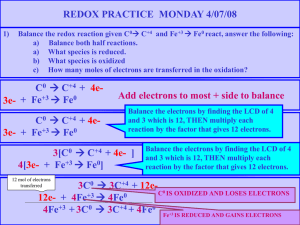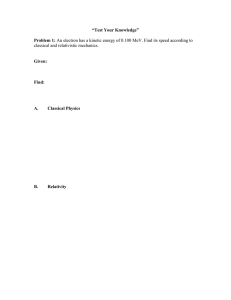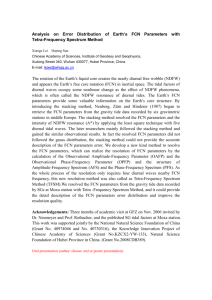Collisions between electrons and ions
advertisement
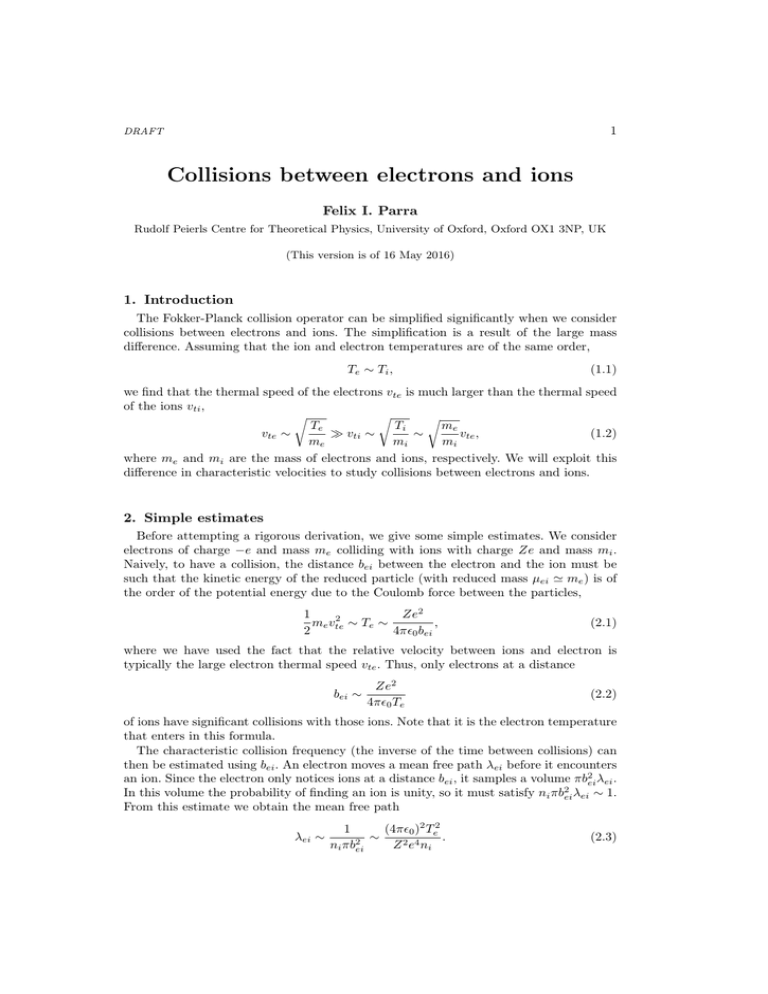
1
DRAFT
Collisions between electrons and ions
Felix I. Parra
Rudolf Peierls Centre for Theoretical Physics, University of Oxford, Oxford OX1 3NP, UK
(This version is of 16 May 2016)
1. Introduction
The Fokker-Planck collision operator can be simplified significantly when we consider
collisions between electrons and ions. The simplification is a result of the large mass
difference. Assuming that the ion and electron temperatures are of the same order,
Te ∼ Ti ,
(1.1)
we find that the thermal speed of the electrons vte is much larger than the thermal speed
of the ions vti ,
r
r
r
Te
Ti
me
vti ∼
∼
vte ,
(1.2)
vte ∼
me
mi
mi
where me and mi are the mass of electrons and ions, respectively. We will exploit this
difference in characteristic velocities to study collisions between electrons and ions.
2. Simple estimates
Before attempting a rigorous derivation, we give some simple estimates. We consider
electrons of charge −e and mass me colliding with ions with charge Ze and mass mi .
Naively, to have a collision, the distance bei between the electron and the ion must be
such that the kinetic energy of the reduced particle (with reduced mass µei ' me ) is of
the order of the potential energy due to the Coulomb force between the particles,
1
Ze2
2
me vte
∼ Te ∼
,
2
4π0 bei
(2.1)
where we have used the fact that the relative velocity between ions and electron is
typically the large electron thermal speed vte . Thus, only electrons at a distance
bei ∼
Ze2
4π0 Te
(2.2)
of ions have significant collisions with those ions. Note that it is the electron temperature
that enters in this formula.
The characteristic collision frequency (the inverse of the time between collisions) can
then be estimated using bei . An electron moves a mean free path λei before it encounters
an ion. Since the electron only notices ions at a distance bei , it samples a volume πb2ei λei .
In this volume the probability of finding an ion is unity, so it must satisfy ni πb2ei λei ∼ 1.
From this estimate we obtain the mean free path
λei ∼
(4π0 )2 Te2
1
∼
.
2
ni πbei
Z 2 e4 ni
(2.3)
2
Felix I. Parra
With the mean free path, we obtain the collision frequency
νei ∼
Z 2 e4 ni
vte
∼
.
1/2 3/2
λei
(4π0 )2 me Te
(2.4)
This estimate ignores the fact that small angle collisions with impact parameter larger
than bei but smaller than the Debye length λD dominate. To include the effect of these
small angle collisions, we only need to recall that we estimated the effect of small angle
collisions to be larger than the effect of large angle collisions by a Coulomb logarithm
ln Λei 1. A larger effect is roughly equivalent to more collisions, or equivalently, to a
larger collision frequency. Then, we need to multiply(2.4) by a factor of ln Λei to obtain
νei ∼
Z 2 e4 ni ln Λei
1/2
3/2
(4π0 )2 me Te
.
(2.5)
Similar estimates give us the typical collision frequency of electron-electron collisions and
ion-ion collisions,
e4 ne ln Λee
(2.6)
νee ∼
1/2 3/2
(4π0 )2 me Te
and
Z 4 e4 ni ln Λii
νii ∼
.
(2.7)
1/2 3/2
(4π0 )2 mi Ti
The estimate that led to (2.5) is not valid for the effect of ion-electron collisions on
ions. It is true that electrons and ions collide often, but the effect of a single collision on
an ion is small. Due to conservation of momentum, if the change of the electron velocity
in a collision is ∆ve , the change to the ion velocity is
r
me
me
me
∆vi = −
∆ve ∼
vte ∼
vti vti .
(2.8)
mi
mi
mi
Therefore, a single electron-ion collision only modifies the ion velocity by a small amount
of the order of (me /mi )1/2 vti vti . Since collisions are not coherent, they can be thought
of as a random walk in velocity space. To achieve a total change in the ion velocity of
the order of vti , we need a number of electron-ion collisions
2
vti
mi
Nc ∼
∼
1.
(2.9)
|∆vi |
me
Then, the effective collision frequency of ion-electron collisions is 1/Nc smaller than the
electron-ion collision frequency,
1/2
νie ∼
me
Z 2 e4 ni me ln Λei
νei
∼
νei ∼
.
3/2
Nc
mi
(4π0 )2 mi Te
(2.10)
Combining equations (2.5), (2.6), (2.7) and (2.10), and assuming Te ∼ Ti , Z ∼ 1 and
ne ∼ ni , we obtain
r
me
me
νee ∼ νei νii ∼
νei νie ∼
νei .
(2.11)
mi
mi
The electrons collide with electrons as often as they collide with ions. Ions collide with
ions much more rarely, and ions are affected by their collisions with the light electrons
only after a time much longer than the time between collisions with other ions.
Collisions between electrons and ions
3
3. Electron-ion collision operator
We
pions. We perform an expansion
p start with the effect on electrons of collisions with
in me /mi 1. We first consider the lowest order in me /mi 1, and later we keep
higher order terms.
p
3.1. Electron-ion collision to lowest order in me /mi 1
The electron-ion Fokker-Planck collision operator is
#
)
(Z
"
γei
fe (v)
fi (v0 )
3 0
0
Cei [fe , fi ] =
∇v ·
∇g ∇ g g ·
∇v fe (v) −
∇v0 fi (v ) d v .
me
m
m
| e {z√
} | i {z√
}
∼fi fe / me Te
(3.1)
∼fi fe / mi Ti
To find the order of magnitude estimate, we have used ∇v fe ∼ fe /vte and ∇v0 fi ∼ fi /vti .
0
The term m−1
i fe (v)∇v 0 fi (v ) is then negligible. Moreover, we find
g = |{z}
v − |{z}
v0 ' v,
∼vte
(3.2)
∼vti
leading to
v 2 I − vv
.
(3.3)
∇g ∇g g ' ∇v ∇v v =
v3
R
With
this result, and using fi (v0 ) d3 v 0 = ni , equation (3.1) becomes to lowest order in
p
me /mi 1
2
v I − vv
γei ni
∇v ·
· ∇v fe .
(3.4)
Cei [fe , fi ] ' Lei [fe ] =
m2e
v3
This approximate operator is known as Lorentz collision operator or pitch-angle scattering
collision operator.
To understand the pitch-angle scattering operator, we rewrite it using the spherical
coordinates {v, α, β} in velocity space, shown in figure 1. In the orthonormal basis {v̂ =
v/v, α̂ = ∇v α/|∇v α|, β̂ = ∇v β/|∇v β|}, the gradient and divergence with respect to the
velocity of general functions f and Γ are
∇v f = ∇v v
∂f
∂f
∂f
∂f
1 ∂f
1 ∂f
+ ∇v α
+ ∇v β
=
v̂ +
α̂ +
β̂
∂v
∂α
∂β
∂v
v ∂α
v sin α ∂β
(3.5)
and
∂
∂
∂
(J Γ · ∇v v) +
(J Γ · ∇v α) +
(J Γ · ∇v β)
∂v
∂α
∂β
1 ∂
1
∂
1
∂ = 2
v 2 Γ · v̂ +
(sin α Γ · α̂) +
Γ · β̂ ,
v ∂v
v sin α ∂α
v sin α ∂β
∇v · Γ =
1
J
(3.6)
where J = det[∂v/∂(v, α, β)] = [∇v v · (∇v α × ∇v β)]−1 = v 2 sin α is the determinant
of the Jacobian of the transformation v(v, α, β). Using (3.5) and (3.6), equation (3.4)
becomes
γei ni
1 ∂
∂fe
1 ∂ 2 fe
Lei [fe ] = 2 3
sin α
+
.
(3.7)
me v sin α ∂α
∂α
sin2 α ∂β 2
The Lorentz operator diffuses the distribution function in α and β, but leaves its structure
in v unchanged. The reason for this lack of diffusion in v is that electrons do not change
the magnitude of its velocity when they collide with heavy ions. According to (2.8), the
velocity of the ion barely changes in a collision with an electron. Then, the ion kinetic
4
Felix I. Parra
ẑ
v̂
ˆ
v
ˆ
↵
↵
ŷ
x̂
Figure 1. Spherical coordinates {v, α, β} in velocity space. The orthonormal basis
{v̂ = v/v, α̂ = ∇v α/|∇v α|, β̂ = ∇v β/|∇v β|} is also sketched.
energy does not change, and since the total kinetic energy of both the electron and the ion
is conserved, the kinetic energy of the electron is the same before and after the collision.
Thus, only the direction of the electron velocity changes after a collision, leading to the
diffusion in α and β seen in (3.7).
The Lorentz operator tends to make the electron distribution function isotropic, that
is, it tends to give a function fe that is only a function of v and not of α or β. To show this
property, we prove that the Lorentz operator satisfies its own H-theorem. The entropy
production due to the Lorentz operator is
Z
L
σ̇ei
= − ln fe Lei [fe ].
(3.8)
Using (3.4) and integrating by parts, we obtain
Z
v 2 I − vv
γei ni
L
f
∇
ln
f
·
· ∇v ln fe d3 v
σ̇ei =
e
v
e
m2e
v3
2
Z
γei ni
fe v · ∇v ln fe 3
=
∇v ln fe −
v d v
m2e
v v2
"
2
2 #
Z
γei ni
fe
∂fe
1
∂fe
=
+
d3 v > 0.
m2e
v3
∂α
sin2 α ∂β
(3.9)
Thus, the entropy grows until σ̇ei = 0. The entropy production σ̇ei vanishes only when
∇v ln fe is proportional to v, that is, when fe (v) is only a function of the velocity magnitude. Interestingly, we did not need to add the entropy production of the ions due to
electron-ion collisions to show that the entropy increases. The isotropization
p process is
then independent of the ion distribution function because to this order in me /mi 1,
the ions seem just stationary particles compared to the fast electrons.
p
3.2. Electron-ion collision to first order in me /mi 1
We have argued in (2.11) that the electron-ion collisions are much more frequent than
other types of collisions. Thus,pit is usual to have an electron distribution function that
is isotropic to lowest order in me /mi 1,
fe (v) = fe0 (v) + fe1 (v) + . . .
| {z }
|q{z }
isotropic
∼
me
mi
fe0
(3.10)
5
Collisions between electrons and ions
If this is the case,p
we need to continue the expansion of the electron-ion collision operator
to next order in me /mi 1. For ∇g ∇g g, instead of the lowest order approximation
in (3.3), we keep the next order correction to find
∇g ∇g g ≡ M(g) = M(v − v0 ) ' M(v) − v0 · ∇v M(v) = ∇v ∇v v − v0 · ∇v ∇v ∇v v. (3.11)
Substituting this result and the expansion in (3.10) into (3.1), we obtain
(Z "
: 0 due to isotropy
γei
fi (v0 ) Cei [fe , fi ] '
∇v ·
∇v ∇
v
·
∇
f
(v)
+ ∇v ∇v v · ∇v fe1 (v)
v
v e0
me
me #
)
f (v)
e0
−v0 · ∇v ∇v ∇v v · ∇v fe0 (v) −
∇v ∇v v · ∇v0 fi (v0 ) d3 v 0 .
mi
(3.12)
Using
1 ∂fe0
v,
v ∂v
Z
Z
Z
fi (v0 ) d3 v 0 = ni ,
fi (v0 )v0 d3 v 0 = ni ui , ∇v0 fi (v0 ) d3 v 0 = 0,
∇v fe0 (v) =
and
(3.13)
(3.14)
the electron-ion collision operator in (3.12) can be rewritten as
γei ni
Cei [fe , fi ] '
∇v ·
m2e
!
1 ∂fe0
∇v ∇v v · ∇v fe1 −
ui · ∇v ∇v ∇v v · v .
v ∂v
(3.15)
One further useful manipulation is
:0 *· I∇ ∇ v = −∇ ∇ v.
∇v ∇v ∇v v · v = ∇v (
∇v
∇
∇v v
v v · v) − v v
v v
(3.16)
With this result equation (3.15) finally becomes
"
#
ui ∂fe0
γei ni
∇v · ∇v ∇v v · ∇v fe1 +
Cei [fe , fi ] '
m2e
v ∂v
"
#
γei ni
v · ui ∂fe0
v · ui ∂fe0
=
∇v · ∇v ∇v v · ∇v fe1 +
= Lei fe1 +
.
m2e
v
∂v
v
∂v
(3.17)
The electron-electron collisions are usually as frequent as the electron-ion collisions (see
(2.11)), and as a result, it is usually the case that the lowest order electron distribution
function is not only isotropic, but also Maxwellian,
3/2
me
me v 2
fe0 (v) = fM e (v) ≡ ne
exp −
.
(3.18)
2πTe
2Te
If this is the case, equation (3.17) becomes
me v · ui
fM e .
Cei [fe , fi ] ' Lei fe1 −
Te
(3.19)
We have seen that the Lorentz operator tends to make the distribution function
isotropic. Thus, the collision operator in (3.17) will give
fe1 (v) = ge1 (v) −
v · ui ∂fe0
.
v
∂v
(3.20)
6
Felix I. Parra
where ge1 (v) is isotropic. When calculating the total distribution function fe ' fe0 (v) +
fe1 (v), we can absorb the isotropic correction ge1 (v) into the lowest order isotropic distribution function fe0 (v), leading to
fe (v) ' fe0 (v) −
∂fe0
v · ui ∂fe0
' fe0 (v) + (|v − ui | − v)
' fe0 (|v − ui |).
v
∂v
∂v
(3.21)
Then, the electron-ion collisions tend to give an electron distribution function that is
isotropic around the average velocity of the ions ui .
We proceed to calculate the collisional friction force and the collisional energy exchange
using (3.17).
3.2.1. Electron-ion collisional friction force
The collisional force on the electrons is
Z
Fei = me v Cei [fe , fi ] d3 v.
(3.22)
Substituting equation (3.17) into this expression, and integrating by parts, we find
Z
I
ui ∂fe0
γei ni
*
∇v v · ∇v ∇v v · ∇v fe1 +
d3 v
Fei = −
me
v ∂v
Z
γei ni
ui ∂fe0
d3 v.
(3.23)
=−
∇v ∇v v · ∇v fe1 +
me
v ∂v
Integrating the first term in the integral by parts again, we find
Z γei ni
v 2 I − vv
∂fe0
2
Fei =
fe1 ∇v ∇v v −
· ui
d3 v.
me
v4
∂v
(3.24)
To simplify the integral further, we use that fe0 (v) is isotropic, and we take the integral in
the spherical coordinates sketched in figure 1. Since v = v[sin α(cos β x̂+sin β ŷ)+cos α ẑ],
the integral over the angles α and β gives
Z π
Z 2π
v2
v2
1
dα
dβ sin αvv = (x̂x̂ + ŷŷ + ẑẑ) = I.
(3.25)
4π 0
3
3
0
Then,
Z
v 2 I − vv ∂fe0 3
8π
d v=
I
v4
∂v
3
Z
0
∞
∂fe0
8πfe0 (0)
dv = −
I.
∂v
3
(3.26)
Using this expression, and recalling that ∇2v ∇v v = −2v/v 3 , equation (3.24) becomes
Z
γei ni 8πfe0 (0)
v
3
Fei =
ui − 2
f
d
v
.
(3.27)
e1
me
3
v3
The friction force depends on the average ion velocity and on a moment of the correction
to the electron distribution function fe1 . Note that only the value of fe0 at v = 0 enters
in the expression, and that the integral over fe1 is weighed towards smaller v due to the
v −3 . The value of the electron distribution function at low energies is more important
because slow electrons are more likely to have strong interactions with ions.
Expression (3.27) becomes more transparent if we assume that the electron distribution
7
Collisions between electrons and ions
function is a Maxwellian with average velocity ue ∼ ui vte ,
3/2
me
me |v − ue |2
fe (v) = ne
exp −
= fM e (|v − ue |)
2πTe
2Te
me v · ue
v · ue ∂fM e
' fM e (v) −
= fM e (v) +
fM e (v),
| {z }
v
∂v
Te
|
{z
}
fe0 (v)
(3.28)
fe1 (v)
where fM e (v) is the stationary Maxwellian defined in (3.18). In this simple case,
3/2
me
fe0 (0) = fM e (0) =
ne
(3.29)
2πTe
and using (3.25), we find that
Z
Z
me (v · ue )v
v
3
fe1 d v =
fM e d3 v
3
v
v 3 Te
5/2 Z ∞
3/2
me v 2
2ne
2ne ue me
me
exp −
ue . (3.30)
v dv = √
= √
2Te
3 2π Te
3 2π Te
0
With these results, equation (3.27) becomes
Fei = ne me νei (ui − ue ),
where the electron-ion collision frequency is defined to be
√
4
γei ni
4 2π Z 2 e4 ni ln Λei
νei = √
=
.
3/2
3/2
3 (4π0 )2 m1/2
3 2π m1/2
e Te
e Te
(3.31)
(3.32)
3.2.2. Electron-ion collisional energy exchange
The collisional energy gained or lost by the electrons is
Z
1
Wei =
me v 2 Cei [fe , fi ] d3 v.
2
(3.33)
Substituting equation (3.17) into this expression, and integrating by parts, we find
2
Z
γei ni
ui ∂fe0
v
Wei = −
· ∇v ∇v v · ∇v fe1 +
d3 v
∇v
me
2
v ∂v
Z
:0
γei ni
ui ∂fe0
=−
v ·
∇v ∇v v · ∇v fe1 +
d3 v = 0.
(3.34)
me
v ∂v
p
To this order in the expansion in me /mi 1, there is no exchange of energy. The
magnitude of the velocity of the electron barely changes in one collision, and as a result,
the transfer of energy is minimal. To calculate the energy transfer, it is better to use the
ion-electron collision operator.
4. Ion-electron collision operator
We proceed topcalculate the effect on ions of collisions with electrons. We perform
an expansion in me /mi 1. To simplify the problem, we assume that the electron
distribution function is almost isotropic and hence it can be expanded as in (3.10).
8
Felix I. Parra
The ion-electron Fokker-Planck collision operator is
(Z
"
)
#
fi (v)
γei
fe (v0 )
3 0
0
Cie [fi , fe ] =
∇v ·
∇g ∇g g ·
∇v fi (v) −
∇v0 fe (v ) d v .
mi
mi
me
{z√
} |
{z√
}
|
∼fi fe / mi Ti
(4.1)
∼fi fe / me Te
0
The term m−1
i fe (v )∇v fi (v) is then small, and we can use the lowest order approximation
fe (v) ' fe0 (v) in it. We also have
v0 ' −v0 ,
g = |{z}
v − |{z}
∼vti
(4.2)
∼vte
leading to
∇g ∇g g ≡ M(g) = M(v − v0 ) ' M(−v0 ) + v · ∇v0 M(−v0 ) = ∇v0 ∇v0 v 0 − v · ∇v0 ∇v0 ∇v0 v 0 .
(4.3)
With these results, equation (4.1) becomes
γei
Cie [fi , fe ] '
∇v ·
mi
:0
0
fe0 (v 0 )
fi (v) 0
0
0
∇v0 ∇v0 v 0 · ∇v fi (v) −
∇v 0 ∇
v
·
∇
f
(v
)
v
v e0
mi
me #
)
+∇v0 ∇v0 v 0 · ∇v0 fe1 (v0 ) − v · ∇v0 ∇v0 ∇v0 v 0 · ∇v0 fe0 (v 0 ) d3 v 0 .
(Z "
(4.4)
Using (3.13) and (3.16), we find
∇v0 ∇v0 ∇v0 v 0 · ∇v0 fe0 (v 0 ) = −
1 ∂fe0 (v 0 )
∇v 0 ∇v 0 v 0 .
v 0 ∂v 0
(4.5)
Employing (3.23), we obtain
Z
Z
γei
Fei
γei
1 ∂fe0 (v 0 )
−
∇v0 ∇v0 v 0 · ∇v0 fe1 (v0 ) d3 v 0 =
+
ui ·
∇v0 ∇v0 v 0 d3 v 0 .
mi me
ni m i
mi me
v 0 ∂v 0
(4.6)
With these results, equation (4.4) becomes
(Z "
Fei
γei
fe0 (v 0 )
Cie [fi , fe ] '
· ∇v fi +
∇v ·
∇v0 ∇v0 v 0 · ∇v fi (v)
ni mi
mi
mi
#
)
fi (v) ∂fe0 (v 0 )
0
3 0
(v − ui ) · ∇v0 ∇v0 v d v .
(4.7)
−
me v 0 ∂v 0
We finish by taking the integrals. Using (3.25) and ∇v0 ∇v0 v 0 = [(v 0 )2 I − v0 v0 ]/(v 0 )3 , we
find
Z
Z ∞
8π
fe0 (v 0 )∇v0 ∇v0 v 0 d3 v 0 =
I
fe0 (v 0 )v 0 dv 0 .
(4.8)
3
0
Using this result and (3.26), equation (4.7) finally becomes
"
#
Z
Fei
8πγei
∇v f i ∞
fe0 (0)
0 0
0
Cie [fi , fe ] '
· ∇v fi +
∇v ·
fe0 (v )v dv +
(v − ui )fi . (4.9)
ni mi
3mi
mi 0
me
If the electron distribution function is a Maxwellian (see (3.18)), this operator simplifies
Collisions between electrons and ions
9
to
"
#
Fei
ne me νei
Te
Cie [fi , fe ] '
· ∇ v fi +
∇v ·
∇v fi + (v − ui )fi ,
ni mi
ni mi
mi
(4.10)
where νei is defined in (3.32).
We proceed to calculate the collisional friction force and the collisonal energy exchange.
4.1. Ion-electron collisional friction force
The collisional force on the ions is
Z
Fie =
mi v Cie [fi , fe ] d3 v.
(4.11)
Substituting equation (4.9) into this expression, and integrating by parts, we find
#
Z
Z "
Z
8πγei
fe0 (0)
∇ v fi ∞
Fei
3
0 0
0
fi d v −
fe0 (v )v dv +
(v −ui )fi d3 v. (4.12)
Fie = −
ni
3
mi 0
me
Using (3.14), the collisional force becomes
Fie = −Fei ,
(4.13)
as expected.
4.2. Ion-electron collisional energy exchange
The collisional energy gained or lost by the ions is
Z
1
mi v 2 Cie [fi , fe ] d3 v.
Wie =
2
(4.14)
Substituting equation (4.9) into this expression, and integrating by parts, we find
Z "
Z
Z
v · ∇ v fi ∞
8πγei
Fei
3
· fi v d v −
fe0 (v 0 )v 0 dv 0
Fie = −
ni
3
mi
0
#
fe0 (0)
+
v · (v − ui )fi d3 v.
(4.15)
me
R
Using that fi (v − ui ) d3 v = 0, we can write
Z
Z
3
fi v · (v − ui ) d v = fi |v − ui |2 d3 v.
(4.16)
By integrating by parts, we obtain
Z
Z
Z
v · ∇v fi d3 v = − fi (∇v · v) d3 v = −3 fi d3 v = −3ni .
With these results, equation (4.15) becomes
!
Z
Z
8πγei 3ni ∞
f
(0)
e0
fe0 (v 0 )v 0 dv 0 −
fi |v − ui |2 d3 v .
Wie = −Fei · ui +
3
mi 0
me
(4.17)
(4.18)
For an electron Maxwellian distribution function (see (3.18)) and an ion Maxwellian
distribution function
3/2
mi
mi |v − ui |2
fi (v) = fM i (v) ≡ ni
exp −
,
(4.19)
2πTi
2Ti
10
Felix I. Parra
the collisional energy exchange becomes
Wie =
−F · ui
| ei
{z }
+
work done by friction force
3ne me νei
(Te − Ti ).
mi
(4.20)
The first term in (4.20) is the work done by the collisional force Fie = −Fei on the
ions. The second term is a collisional energy exchange proportional to the temperature
difference between electrons and ions. This term will tend to make the ion and electron
temperatures equal, but at the slow rate
ne m e
νei νii νee ∼ νei .
(4.21)
ni mi
Then, the ions and electrons can have many collisions and their distribution functions
become Maxwellians without their temperatures becoming equal. For this reason, it is
possible to find plasmas with very different electron and ion temperatures.
Due to energy conservation, the electron energy gain or loss is
3ne me νei
(Te − Ti )
mi
3ne me νei
+ Fei · (ui − ue ) +
(Ti − Te ).
|
{z
}
mi
Wei = −Wie = Fei · ui −
=
Fei · ue
| {z }
work done by friction force
(4.22)
Joule heating
This collisional energy gain has the work done by the friction force Fei on the electrons,
and the energy exchange due to the temperature difference, but in addition to these two
terms, it contains Joule heating, proportional to the current. This Joule heating term
is due to the transfer of energy from the average electron flow of the electrons to the
electron temperature.
